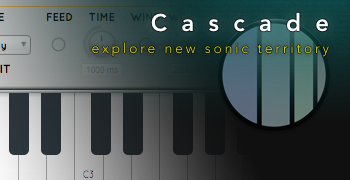With Cascade we give you a completely new playground, creating sounds you could never create before. Cascade is based on a complex delay network that can densify a sound up to 5832 times. That doesn't mean that a sound you create with cascade will per definition sound 'denser'. It can also be more lush and spacious, depending on the settings you choose. What makes Cascade really unique however is that a sound can develop over time, adding extra dimensions to it. And moreover: that you can select the most interesting part of this development process as the part you want to hear. The presets will give you a good idea of what Cascade is capable of. But don't let yourself be limited by our suggestions. Let your creativity flow, and create your own mysterious soundscapes, dense orchestral sounds, or otherworldly strings. Or something more 'industrial' or ambient' if that's what you are after.
Demos
Epy Trap Funk
Some real funky stuff in the notorious Falkensteiner Strasse style.
Magenta
Sound designer Jonathan Adams Leonard shows that there is more to Cascade than meets the eye.
Go with the flow
Sit back and relax. Close your eyes and imagine you are in an alien world, far far from here. A few of our favourite Cascade presets (in order of appearance): Bang Sweep, Polar Express, Sentimental Strings, Mysterious, Slowness, Buck Rogers, Glissando Up.
Background
By condensation successive events are transformed into the simultaneity of a spectrum. A succession of sounds as an input turns into a color of sound as an output. (Peter Ablinger, 1997)
The making of Cascade was inspired by the work of Austrian composer Peter Ablinger. He experimented in the late 1980's with sound densification using 12 tape decks. Sound was recorded and played, recorded and played, and so on, until colored static noise itself was the result. In 1993-94 Peter Ablinger's concept of sound densification was refined by Peter Bðhm, Wolfgang Musil (ELAK, University of Music and Performing Arts, Vienna) and Thomas Musil (IEM, Institute of Electronic Music and Acoustics, Graz). Thanks to the IRCAM Signal Processing Workstation (ISPW), that contained an at the time incredible powerful audio processor could for the first time sound densification be achieved in real time.
We took those early concepts to the next level: an actual synthesizer that can 'condense sounds in time'. The output of Cascade shows only a marginal resemblance to those revolutionary sound experiments though. The sound variation in a synthesizer however is far more subtle than the different sounds played by for example a violin. A synthesizer has no obvious 'successive events'. You must create them by skillfully adjusting the envelope or the LFO. Luckily our aim wasn't to replicate. Colored static noise wasn't really what we were after. What we wanted was to take this intriguing concept to the realm of synthesis to open up a complete new sonic territory. In our opinion it's precisely the subtlety that makes sound densification such an interesting addition to the modern sound repertoire. And of course, we couldn't resist the temptation to add 'a little spice', most importantly the possibility to modulate the cascade synthesis itself. This makes it possible to create sounds with a unique character. If you want to compare it to something anyway, we would say: a super fat chorus ensemble.
System requirements
Windows : 7, and up
Mac OS X (Intel or Apple Silicon ): 10.8 (Mountain Lion), and up
Native Apple M1 support
Please note that the AU plugin might only show up after you rebooted your computer.
Cascade is available in VST (64-bit), AU (64-bit), and AAX (64-bit) format.




